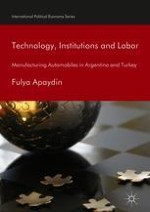2018 | OriginalPaper | Buchkapitel
4. A Persistent Refusal: Córdoba’s Contentious Workers in Federal Argentina
verfasst von : Fulya Apaydin
Erschienen in: Technology, Institutions and Labor
Aktivieren Sie unsere intelligente Suche, um passende Fachinhalte oder Patente zu finden.
Wählen Sie Textabschnitte aus um mit Künstlicher Intelligenz passenden Patente zu finden. powered by
Markieren Sie Textabschnitte, um KI-gestützt weitere passende Inhalte zu finden. powered by
